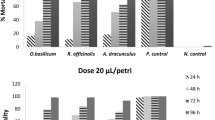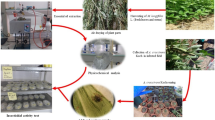Abstract
The effect of essential oil (EO) from anise (Pimpinellia anisum) on the mortality of young larvae of Colorado potato beetles has been studied. In our bioassays, P. anisum EO significantly increased the mortality of the second instar larvae of L. decemlineata. Significantly different values of LD50 and LD90 were established for acute (LD50 = 1.76, and LD90 = 8.29) as well as chronic toxicity (LD50 = 0.45, and LD90 = 1.01). Decrease of both values over experimental period was evident, which showed that the larval mortality was slow and cumulative. The composition of EO used for biological experiments was also assessed. The main component detected in EO from P. anisum was anethole (79.87%), followed by anisaldehyde (7.74%), estragole (5.88%) and β-linalool (1.07%). Within five days, residual concentration of EO decreased from 3.87 mg/g of dry weight immediately after foliar applications to 0.9 mg per g of dry weight. The effect of this slow evaporation could be explained by dominant presence of anethole or by the type of formulation and the addition of oil and tween. Results of our study demonstrate that EO from P. anisum has insecticidal properties that may lead to the development of new organic products for the control of Colorado potato beetles.
Resumen
Se estudió el efecto del aceite esencial (EO) del anis (Pimpinellia anisum) en la mortalidad de larvas jóvenes del escarabajo de Colorado. En nuestros bioensayos, el EO de P. anisum incrementó significativamente la mortalidad de las larvas de segundo instar de L. decemlineata. Se establecieron valores significativamente diferentes de LD50 y LD90 para toxicidad aguda (LD50 = 1.76 y LD90 = 8.29), así como para toxicidad crónica (LD50 = 0.45 y LD90 = 1.01). La disminución de ambos valores sobre el período experimental fue evidente, lo que mostró que la mortalidad de las larvas fue lenta y acumulativa. También se analizó la composición del EO usado para los experimentos biológicos. El principal componente detectado en EO de P. anisum fue anelthol (79.87%), seguido de anisaldehido (7.74%), estragol (5.88%) y β-linalool (1.07%). En cinco días, la concentración residual de EO disminuyó de 3.87 mg/g de peso seco inmediatamente después de las aplicaciones foliares, a 0.9 mg por g de peso seco. El efecto de esta lenta evaporación pudiera explicarse por la presencia dominante de anelthol o por el tipo de formulación y la adición de aceite y tween. Los resultados de nuestro estudio demuestran que el EO de P. anisum tiene propiedades insecticidas que pudieran conducir al desarrollo de nuevos productos orgánicos para el control del escarabajo de Colorado.
Similar content being viewed by others
References
Abbott, W.S. 1925. A method of computing the effectiveness of an insecticide. Journal of Economic Entomology 18: 263–267.
Abdel-Kader, M., N. El-Mougy, and S. Lashin. 2011. Essential oils and Trichoderma Harzianum as an integrated control measure against Faba bean root rot pathogens. Journal of Plant Protection Research 51(3): 306–313.
Adams, R. P. 2007. Identification of Essential Oil Components by Gas Chromatography/Mass Spectroscopy. 4th edition. Allured Pub Corp.
Alyokhin, A., G. Dively, M. Patterson, C. Castaldo, D. Rogers, M. Mahoney, and J. Wollam. 2007. Resistance and cross-resistance to imidacloprid and thiamethoxam in the Colorado potato beetle Leptinotarsa decemlineata. Pest Management Science 63(1): 32–41.
Alyokhin, A., M. Udalov, and G. Benkovskaya. 2013. The Colorado potato beetle. In Insect pests of potato: global perspectives on biology and management, ed. P. Giordanengo, C. Vincent, and A. Alyokhin, 11–29. Oxford, UK: Academic Press.
Chang, K.S., and Y.J. Ahn. 2002. Fumigant activity of (E)-anethole identified in Illicium verum fruit against Blattella germanica. Pest Management Science 58(2): 161–166.
Chang, C.L., I.K. Cho, and Q.X. Li. 2009. Insecticidal activity of basil oil, trans-anethole, estragole, and linalool to adult fruit flies of Ceratitis capitata, Bactrocera dorsalis, and Bactrocera cucurbitae. Journal of Economic Entomology 102(1): 203–209.
Coats, R., L.L. Karr, and C.D. Drewes. 1991. Toxicity and neurotoxic effects of monoterpenoids in insects and earthworms. In Natural occurring Pest Bioregulators. American Chemical Society symposium series, ed. P. Hedin, vol. 449, 305–316.
Costa, S.D., M.E. Barbercheck, and G.G. Kennedy. 2001. Mortality of Colorado potato beetle (Leptinotarsa decemlineata) after sublethal stress with the CryIIIA δ-endotoxin of Bacillus thuringiensis and subsequent exposure to Beauveria bassiana. Journal of Invertebrate Pathology 77(3): 173–179.
El-Mougy, N. 2009. Effect of some essential oils for limiting early blight (Alternaria Solani) development in potato field. Journal of Plant Protection Research 49(1): 57–62.
Enan, E. 2001. Insecticidal activity of essential oils: octopaminergic sites of action. Comparative Biochemistry and Physiology Part C 130: 325–337.
Felipe, C.F.B., K.S. Fonsêca, A.L.R. Barbosa, J.N.S. Bezerra, M.A. Neto, M.M. França Fonteles, and G.S. Barros Viana. 2008. Alterations in behavior and memory induced by the essential oil of Zingiber officinale roscoe (ginger) in mice are cholinergic-dependent. Journal of Medicinal Plant Research 2(7): 163–170.
Finney, D.J. 1971. Probit Analysis. London: Cambridge University Press.
Freire, R.S., S.M. Morais, F.E.A. Catunda-Junior, and D.C. Pinheiro. 2005. Synthesis and antioxidant, anti-inflammatory and gastroprotector activities of anethole and related compounds. Bioorganic & Medicinal Chemistry 13(13): 4353–4358.
Haffani, Y.Z., C. Cloutier, and F.J. Belzile. 2001. Bacillus thuringiensis cry3Ca1 protein is toxic to the Colorado potato beetle, Leptinotarsa decemlineata (Say). Biotechnology Progress 17(2): 211–216.
Ho, S.H., Y. Ma, and Y. Huang. 1997. Anethole, a potential insecticide from Illicium verum hook F., against two stored product insects. International Pest Control 39(2): 50–51.
Isman, M.B. 2006. Botanical insecticides, deterrents, and repellents in modern agriculture and an increasingly regulated world. Annual Review of Entomology 51: 45–66.
Letizia, C.S., J. Cocchiara, J. Lalko, and A.M. Api. 2003. Fragrance material review on linalool. Food and Chemical Toxicology 41(7): 943–964.
Mitscherlich, A.E. 1909. Das Gesetz des Minimums und das Gesetz des abnehmenden Bodenertrages. Landwirtschäft Jahrbuch 38: 537–552.
Mordue, A.J., and A.J. Nisbet. 2000. Azadirachtin from the Neem tree Azadirachta indica: its action against insects. Anais da Sociedade Entomológica do Brasil 29(4): 615–632.
Mota-Sanchez, D., R.M. Hollingworth, E.J. Grafius, and D.D. Moyer. 2006. Resistance and cross-resistance to neonicotinoid insecticides and spinosad in the Colorado potato beetle, Leptinotarsa decemlineata (Say) (Coleoptera: Chrysomelidae). Pest Management Science 62(1): 30–37.
Nenaah, G.E., and S.I. Ibrahim. 2011. Chemical composition and the insecticidal activity of certain plants applied as powders and essential oils against two stored-products coleopteran beetles. Journal of Pest Science 84(3): 393–402.
Pavela, R. 2007. The feeding effect of polyphenolic compounds on the Colorado potato beetle (Leptinotarsa decemlineata Say). Pest Technology 1: 81–84.
Pavela, R. 2014. Insecticidal properities of Pimpinella anisum essential oils against the Culex quinquefasciatus and the non-target organism Daphnia magna. Journal of Asia-Pacific Entomology 17: 287–293.
Roman, R., and N. Vrchotová. 2013. Insecticidal effect of furanocoumarins from fruits of Angelica archengelica L. against larvae Spodoptera littoralis Boisd. Industrial Crops and Products 43: 33–39.
Sampson, B.J., N. Tabanca, N.E. Kirimer, B. Demirci, K.H.C.B. Baser, I.A. Khan, J.M. Spiers, and D.E. Wedge. 2005. Insecticidal activity of 23 essential oils and their major compounds against adult Lipaphis pseudobrassicae (Davis) (Aphididae: Homoptera). Pest Management Science 61(11): 1122–1128.
Skuhrovec, J., O. Douda, R. Pavela, and M. Zouhar. 2015. Výzkum vlivu aplikace rostlinných esencí na mortalitu mandelinky bramborové (Plant essences as tool for management of Colorado potato beetle). Úroda 63(5): 89–91 (in Czech, title and abstract in English).
Whitehorn, P.R., S. O’Connor, F.L. Wackers, and D. Goulson. 2012. Neonicotinoid pesticide reduces bumble bee Colony growth and queen production. Science 336(6079): 351–352.
Zarubova, L., L. Kourimska, M. Zouhar, P. Novy, O. Douda, and J. Skuhrovec. 2015. Botanical pesticides and their human health safety on the example of Citrus sinensis essential oil and Oulema melanopus under laboratory conditions. Acta Agriculturae Scandinavica, Section B - Plant Soil Science 65(1): 89–93.
Acknowledgements
This study was supported by a research grant from the Czech Ministry of Agriculture nr. QJ1310226 (JS, OD, RP, MZ) and CIGA 20162004 (PK, MB). The authors would like to thank Mrs. Irena Kubečková and Mrs. Sonja Mandíková for technical assistance.
Author information
Authors and Affiliations
Corresponding author
Rights and permissions
About this article
Cite this article
Skuhrovec, J., Douda, O., Pavela, R. et al. The Effects of Pimpinella anisum Essential Oils on Young Larvae Leptinotarsa decemlineata Say (Coleoptera: Chrysomelidae). Am. J. Potato Res. 94, 64–69 (2017). https://doi.org/10.1007/s12230-016-9549-x
Published:
Issue Date:
DOI: https://doi.org/10.1007/s12230-016-9549-x




